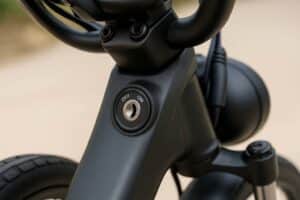If you’re trying to pick between a 2-inch and a 1-1/4-inch e-bike rack mount, it all comes down to weight, stability, and what kind of vehicle you drive.
These two sizes aren’t interchangeable, and choosing the wrong one can lead to a wobbly ride, or worse, damage to your bike or car.
This guide breaks down the difference so you can choose the right fit for your e-bike setup.
Key Takeaways:
- 2-inch mounts are stronger and better for heavy e-bikes or multiple bikes.
- 1-1/4-inch mounts are easier to handle and fit smaller cars.
- The hitch receiver on your car decides what you can install.
- Always check your rack and vehicle’s weight limits before buying.
What Is the Difference Between 2in and 1 1/4 in E-Bike Rack Mount?
A 2-inch e-bike rack mount is stronger and more stable, making it better for heavy e-bikes or multiple bikes. A 1-1/4-inch mount is lighter, easier to install, and typically used on smaller vehicles.
The difference mainly comes down to how much weight the mount can support and how securely it holds your bikes during transport.
Bigger isn’t always better; it depends on your vehicle, how many bikes you’re hauling, and how often you use the rack.
Here’s a side-by-side breakdown:
| Feature | 2-Inch Rack Mount | 1-1/4-Inch Rack Mount |
|---|---|---|
| Weight Capacity | Up to 500 lbs | Up to 200–300 lbs |
| Bike Capacity | 2–4 e-bikes | 1–2 e-bikes |
| Stability | More stable, less sway | May sway with heavier loads |
| Vehicle Fit | Trucks, SUVs, large crossovers | Sedans, compact SUVs, hybrids |
| Installation Ease | Heavier and bulkier | Lighter and easier to handle |
| Price Range | Usually higher | Usually lower |
Weight Capacity: Can It Handle Your Load?
2-inch mounts can handle more weight, up to 500 pounds, while 1-1/4-inch mounts top out around 200 to 300 pounds.
That means if you’re carrying two fat-tire e-bikes or a fully loaded cargo e-bike, you’re much safer with a 2-inch rack.
These mounts are typically Class III rated and built for heavier loads. Most 1-1/4-inch hitches fall under Class I or II, which are fine for one or two lightweight e-bikes but not ideal for anything beyond that.
Keep in mind: the actual rack also has its own weight rating. So even if your hitch can hold 300 pounds, your rack might max out at 150.
Always check both numbers, hitch, and rack before loading up.
Stability and Road Performance
When you’re driving on bumpy roads or at highway speeds, the last thing you want is your rack swaying in your rearview mirror. That’s where the 2-inch mount shines; it offers a tighter fit and less movement thanks to its thicker connection point.
A 1-1/4-inch rack can still be stable for light use, especially on short city trips.
But if you’re heading on a road trip or taking a few e-bikes into the hills, it might feel a bit shaky, especially without an anti-rattle device.
Many racks now come with stabilizers, or you can buy anti-wobble hitch tighteners separately.
But even then, 2-inch mounts naturally offer more peace of mind for longer drives or rough terrain.
Vehicle Compatibility
2-inch rack mounts are made for larger vehicles like trucks and SUVs, while 1-1/4-inch mounts are typically found on sedans, compact SUVs, and hybrids.
Before you shop for a rack, check your vehicle’s hitch receiver size. Most full-size vehicles come standard with a 2-inch receiver because they’re built to tow and carry more weight.
That’s why 2-inch racks are more common in heavy-duty setups.
If you drive a smaller car, chances are you have a 1-1/4-inch receiver. While it’s more limited in what it can carry, it’s often plenty for basic e-bike transport.
You can technically use an adapter, but that usually comes with trade-offs like extra movement and reduced stability.
Installation and Everyday Use
1-1/4-inch mounts are lighter and easier to handle, while 2-inch mounts can be bulky but more robust. If you’re frequently removing the rack, the lighter weight of a 1-1/4-inch model is a real advantage.
You can usually lift and attach it solo without much trouble. It’s also more manageable for daily use, like quick errands or local rides.
On the other hand, 2-inch racks are heavier and might require two people to install, especially if you’re using a platform-style rack.
That said, once installed, they feel sturdier and hold up better to daily wear, especially if you leave them on your vehicle most of the time.
Price and Value
1-1/4-inch mounts are usually cheaper, but 2-inch mounts offer more flexibility and long-term value.
If you’re on a budget, a 1-1/4-inch rack will likely save you some cash upfront. It’s a good choice if you already know you won’t need to carry more than one or two lightweight e-bikes.
But if you’re thinking long-term, or might upgrade your e-bike setup down the line, a 2-inch rack is often worth the investment. You can see our top-tested picks in the best bike rack for electric bikes list.
It can grow with your needs, carry more gear, and handle tougher trips without needing an upgrade.
Which One Should You Get?
Choose a 2-inch rack mount if you carry heavier bikes or want more stability. Go with a 1-1/4-inch mount if you drive a smaller vehicle or want something lighter and easier to manage.
Best for 2-Inch Rack Mount:
- Carrying two or more e-bikes
- Transporting fat-tire or cargo e-bikes
- Driving an SUV, truck, or van
- Long road trips or rougher roads
- Using heavy-duty racks with extra accessories
Best for 1-1/4-Inch Rack Mount:
- Driving a sedan, hatchback, or compact SUV
- Transporting one or two lightweight e-bikes
- Installing and removing the rack frequently
- Staying on city roads and short commutes
- Looking for a budget-friendly solution
What if You Need to Switch Sizes?
You can use a hitch adapter to switch between 1-1/4-inch and 2-inch rack mounts, but it often reduces stability and isn’t ideal for heavy loads.
Adapters are a quick fix if your bike rack and hitch receiver don’t match.
For example, if your vehicle has a 1-1/4-inch hitch and your rack is made for 2-inch receivers, an adapter sleeve might make it work.
But there’s a trade-off, using an adapter can introduce more movement and wobble, especially at higher speeds or over bumpy roads.
Most rack manufacturers even advise against adapters for e-bike use, especially if you’re nearing the weight limit.
If you’re frequently switching vehicles or planning to carry multiple e-bikes, it might be worth upgrading to a properly matched hitch receiver or rack to avoid extra stress and safety concerns.
Final Words
When comparing 2-inch and 1-1/4-inch e-bike rack mounts, it really comes down to weight, stability, and your vehicle type.
If you’re hauling heavier e-bikes or planning long trips, a 2-inch rack mount is usually the safer and more stable choice.
But for lighter setups or city use, a 1-1/4-inch mount can get the job done without the bulk.
Whichever size you go with, make sure the rack fits your car, supports your bike’s weight, and holds up to the way you ride.
It’s not just about size, it’s about finding the right setup that keeps your e-bike safe and secure on every trip.
FAQs
Can I carry 2 e-bikes on a 1-1/4-inch rack?
Yes, but only if their combined weight stays within the rack’s limit—usually around 200 to 300 pounds. Always check the specs before loading up.
Can I use a hitch adapter?
You can, but it’s not recommended for e-bikes. Adapters can cause extra movement, reduce stability, and might void your rack’s warranty.
Why is my rack swaying during driving?
Swaying usually comes from an improper fit or an overloaded rack. Try using an anti-rattle hitch tightener, and double-check your weight limits and hitch class.
Do 2-inch racks last longer?
In most cases, yes. They’re built for heavier use and tend to be more rugged, especially if you’re carrying multiple bikes or riding off-road often.
Michael Josh is a hands-on e-bike tester and reviewer at BoltBikers, known for putting every model through real-world rides before sharing his thoughts. With a sharp eye for performance, comfort, and build quality, he helps the team choose which bikes are worth featuring. Backed by years of experience in tech and gear reviews, Michael brings trusted, honest insights to help readers find the right e-bike for their needs.








